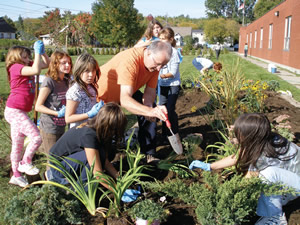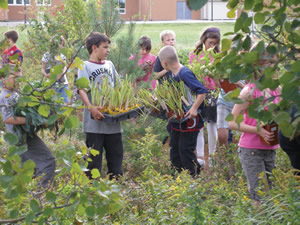Greening Schoolyards

PHOTOS COURTESY OF WAYNE HUGLI
As school facilities planners and managers, parent committee members, community groups, concerned citizens and architects, we can contribute to the re-greening movement by greening schoolyards.
Barren lands resulting from deforestation, urban development, overgrazing animals and droughts have left scars of destruction and environmental damage. Today re-greening, the primary process of bringing back vegetation and plant life to degraded and deforested landscapes is de rigeur. At the 2014 U.N. Climate Summit, Ethiopia announced plans to restore 15 million hectares on the hillsides of Tigray. It was a response to a pledge that by 2030 an estimated total of 350 million hectares will be restored, covering areas in Uganda, the Democratic Republic of the Congo, Colombia, Guatemala and Chile.
Re-greening is happening at the urban scale as well. In compact cities, it not only beautifies the urban environment, but also provides “green infrastructure” that helps to purify air, reduce global warming, reduce flooding and water pollution; in addition, tree-lined streets have commercial benefits and a positive influence on the safety of neighborhoods. Crucially, green infrastructure also provides necessary habitats for animals and insects.
Greening schoolyards
Efforts to naturalize schoolyards are joining the re-greening movement, and its effects go beyond school grounds.
On average, schoolyards cover more than 68 percent of school properties, as a study of 258 public elementary and middle schools in Baltimore, Boston and Detroit has shown. However, this coverage is predominantly turf grass and impervious surface, with as little as 10 percent tree canopy. Schoolyards are large stretches of hard, impervious groundcover next to asphalt parking lots, mega-box stores, roads and freeways.

Healthy learning. Studies show that children do better in natural environments, that being outdoors can help increase children’s attention, and that hands-on nature study improves academic performance. In fact, one study suggests that exposure to nature, or “green time,” can be used as treatment for attention-deficit/hyperactivity disorder (ADHD).
Children do better in natural environments. Research has shown that being outdoors increases children’s attention spans and that hands-on nature study improves academic performance. One study (Kuo and Taylor, 2004) further suggests that exposure to nature, or “green time,” can be used as treatment for attentiondeficit/hyperactivity disorder (ADHD).
A 2014 study published in the journal Health and Place concluded that access to nature reduced stress and promoted resilience. The research was conducted by a team led by Dr. Louise Chawla, environmental psychologist and professor at the University of Colorado; they made their findings by studying three focus groups: a wooded area for recess for elementary school children aged six to twelve, an outdoor classroom for older children aged nine to thirteen, and gardening programs for high school students aged fourteen to eighteen. The study’s findings confirm that when children are given naturalized environments to play and learn in there is a reduction in stress, anger and inattentiveness. Notably, the University Colorado study also discovered that “children under conditions of hardship and stress often seek refuge in nature for restoration and healing.”
Early exposure to nature also encourages children to grow up to be ecologically mindful adults. As Chawla reported in another published study, childhood play and exploration in nature is an important motivation to care for nature later in life, which leads to possessing a sense of efficacy and knowledge of action.
Schoolyards that today are no better than parking lots can be naturalized with woodlands, gardens and nature-based spaces for learning. A local example in Sudbury, Ontario, provides an inspiring example of what is possible.
It takes a community
Environmental activism is in the blood of this northern Canadian city. Sudbury boasts 330 lakes, and while a large part of the year is deep in wintry cold, its summer is lush and green — yet it was not always like this for the mining town, which was the poster child for environmental disaster in the 1970s. Covered in black soot, this region of the Cambrian Shield was barren due to over-logging and acid rain from metal processing. Sudbury’s regreening caught the world’s attention when scientists and citizens got together to start the landscape healing process by liming and replanting. Decades later, it is a symbol of hope and possibility for landscape restoration.
The local greening of schoolyards is a continuation of Sudbury’s environmental activism tradition. One of its most involved citizens is Wayne Hugli, a retired schoolteacher who was an early member of VETAC, a community-based re-greening advisory panel established in 1973. Hugli originated the Ugliest Schoolyard Contest in 2005. The contest — which got its name from a similar contest initiated by the Canadian Biodiversity Institute in 1998— has supported the transformation of many asphalt schoolyards.
“In the first two years we worked with one school per year and relied on in-kind donations from organizations and businesses who were interested in supporting our schoolyard re-greening initiatives,” says Hugli. “In the third year Sudbury Integrated Nickel Operations: a Glencore Company (formerly known as Xstrata Nickel) expressed an interest in funding our projects and we were able to expand to support several schools each year through the contest. The contest winners received financial support as well as in-kind support from a wide variety of donors and supporters, while the runner-up prize winners receive only financial support and advice.” He adds: “To date, we have received a total of $600,000 from corporate sponsors.”
Much attention is given to design in the greening process. As Hugli says, “when we are working with school communities on their schoolyard projects we try to include components that will create an outdoor classroom where teachers can integrate that space into their curriculum”; he notes that “In some cases we have added park benches, but whenever possible, we encourage the use of more natural material such as large stones and logs, etc. to create gathering spaces for students.”
The use of native plants is also crucial in the greening process; Hugli explains that given their appropriateness and adaptability to the local climate, indigenous plants do better and have “a much better long-term survival rate.”
Naomi Grant, a local environmentalist and activist, points out that “just as important as providing funding and direct assistance with planting and so on,” the Ugliest Schoolyard Contest “helps assess and build capacity for long term maintenance, so that there is lasting benefit.” She adds, “It has contributed to a shift in realizing the importance of nature in schoolyards, which can often be paved and barren.”
What seems to be a straightforward mission to green schoolyards in fact requires the collaboration of many committed people who, in addition to the corporate financial support, depend on a cadre of volunteers ranging from members of the Sudbury Horticultural Society and Sudbury Master Gardeners to landscape architects, teachers, parents, and not least the children themselves.
Hugli says the involvement of parents and students “creates more ownership of the re-greening work that has been done and helps to encourage ongoing maintenance.”
The effects of re-greening extend beyond school property. “Re-greened schoolyards can be part of a network of urban green spaces that create ecological connectivity,” Grant says. For instance, if rain gardens are used, re-greened schoolyards can help reduce flooding and filter out pollutants: “Water quality is something everyone can relate to and cares about.”
Grant sees re-greened schoolyards as being neighborhood parks as well. She would like to see “kids play with friends, families connect with each other while their children play, neighbors go for walks and chat with each other. Making schoolyards green and pleasant benefits kids during the school day, but also benefits the whole neighborhood, and increases social cohesion by becoming a meeting place, and a place when there is collaboration on this shared space.”
However, she says, “unfortunately, school board decisions are not connected to urban planning decisions, so these values can be lost when neighborhood schools close.”
Re-greening schoolyards is a major step towards children’s well being in the day-today routine of school life. It requires commitment from many stakeholders; it requires leadership from people who are dedicated to lead and organize; and it requires intensive social involvement. In sum, it takes a community to green schoolyards.
This article originally appeared in the issue of .